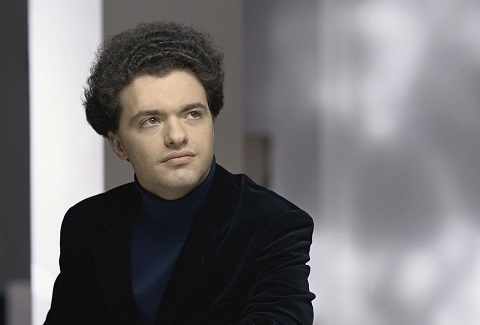 United States Chopin, Schumann, Rachmaninoff: Evgeny Kissin (piano), Davies Symphony Hall, San Francisco. 14.10.2018. (HS)
United States Chopin, Schumann, Rachmaninoff: Evgeny Kissin (piano), Davies Symphony Hall, San Francisco. 14.10.2018. (HS)

Chopin — Nocturne in E major Op.62 No.2; Nocturne in F minor Op.55 No.1
Schumann — Piano Sonata No.3 in F minor Op.14
Rachmaninoff — Seven selections from Ten Preludes Op.23; Three selections from Thirteen Preludes Op.32
Evgeny Kissin, making his first San Francisco appearance in more than four years, got off to an unpromising start with a uncharacteristically blunt warmup, two Chopin nocturnes, which opened his 2 1/2-hour (including encores) recital Sunday evening in Davies Symphony Hall.
But then the pianist turned to Schumann, blazing through the virtuosic Sonata No.3 in F minor, and never looked back. He managed to weave together Schumann’s episodic, ever-shifting moods into a narrative that felt coherent and inevitable.
The pianist, who just turned 47, probes the depths with the best of them. He has formidable technique, but his only form of showing off seems to be a penchant for rapid tempos. Even slow selections are filtered through his interpretations with a palpable pulse. The result is music-making of a high order, gripping in its eloquence and elegance more than flashiness or color.
The sustain pedal might slur some phrases other pianists execute with more clarity, but Kissin aims to create a mood or sound-picture that fits his concept of the material — an artist fashioning an interpretation worth pondering.
Those aspects were most evident in the second half, a revealing tour through 10 of Rachmaninoff’s 23 preludes. He downplayed the flamboyant pianism of Op.23’s Prelude No.2 in B-flat major, a tour-de-force of technique, in favor of sheer propulsion. Then, in No.3 in D minor, he accented the staccato elements of the quietly punchy chords and flourishes, creating a sardonic mood vaguely reminiscent of Prokofiev.
No.4 in D major spun a gossamer web of harmony with curlicues of coloratura circulating around the gentle tune, revealing a velvety texture. The challenging quick octaves of No.5 in G minor, the most familiar of the group here, came off with lightness and and precision.
A dreamy mood infused No.6 in E-flat major, and in No.7 in C minor, constant pedaling created a haze of flittering harmonies, yet somehow it all worked with crisply articulated melodic gestures.
From Op.32 the melancholy No.10 in B minor emerged with a welcome soulfulness, and for a finale No.13 in D-flat major traced an arc from its somber opening to dramatic — and finger-busting — finish. Again, Kissin kept the flamboyance in check to create impressive weight.
A capacity audience showered him with sustained and highly vocal cheering. Each curtain call elicited the sort of noise usually heard when a basketball player makes a game-winning shot. Smiling, soaking it in, finally bowing to the audience in front, slowly turning to those in the choir loft in back of him, he rewarded the faithful with four carefully honed encores.
The first, Schumann’s Träumerei, held back on emotion in favor of steadiness, a study in quiet simplicity. But then came a barn-burner of Kissin’s own, which only increased excitement. Against a lively tango rhythm, he set a jagged modernist tune and pungent harmonies in Dodecaphonic Tango, sounding like the love child of Kurt Weill and Astor Piazzola.
Even better, Chopin’s heroic Polonaise in A-flat might have been the single most impressive few minutes of the entire evening — remarkable for its precision, pianistic flair and control of dynamics.
Finally, to calm things and send everyone home exhaling, he shaped a wistful presence to Scriabin’s étude Op.2 No.1 in C-sharp minor.
Harvey Steiman